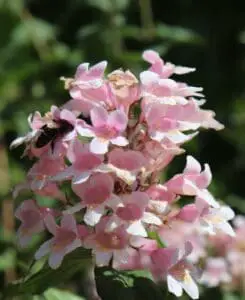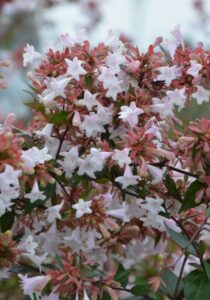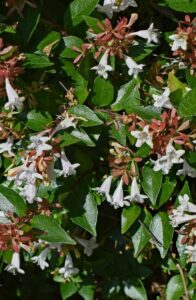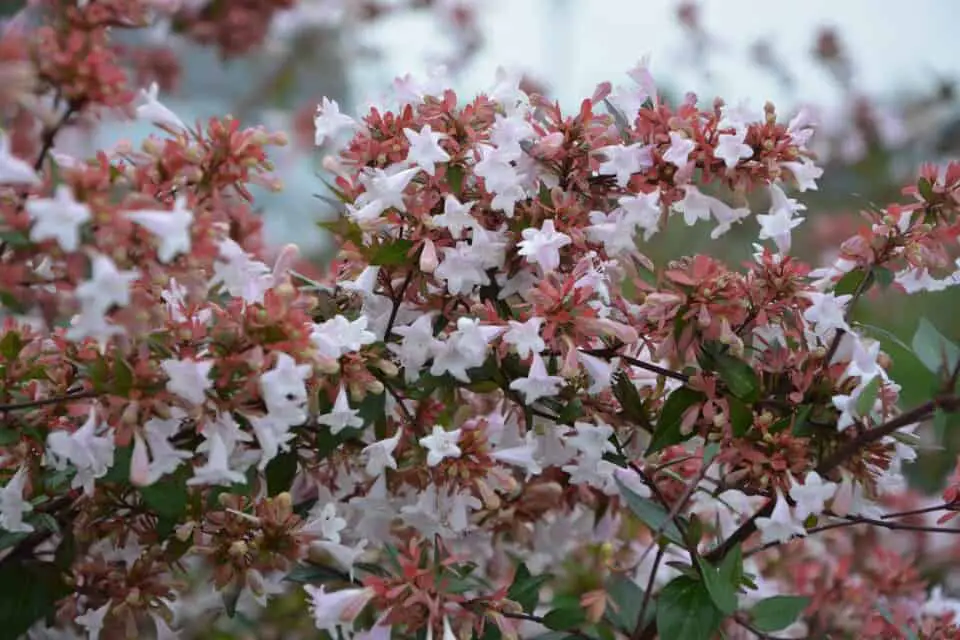Some links in the post are affiliate links and I get a commission from purchases made through some links found in the post.
Do you remember the saying Winter is Coming? For Game of Thrones (GOT) fans, this was a phrase that would send them scurrying home to stream the latest season.
If you missed the memes that surrounded this series, I’d recommend watching a season or two, and you would understand the love for the storyline.
And while people were running indoors to watch this or other series, I was rushing outside. The nearing of winter means something entirely different for gardeners.
We must think of how the weather changes will affect our plants and whether we need to step in to protect them.
Most people growing abelias rarely ever need to think about overwintering the plants. After all, most species are grown outdoors and are left to withstand the temperature changes.
To care for your Abelia over winter you need to make sure they have the right amount of water, lighting, nutrition and correct pruning.
The good thing is that once an abelia establishes, it can take care of itself quite well. But there are considerations to keep in mind when overwintering young or potted abelias, as I will detail in this guide:
What Temperature Is Too Cold for An Abelia?
 The main reason people overwinter their plants is to keep them safe from the sudden drop in temperatures. So, what’s too low for the abelia, and how can you overcome this?
The main reason people overwinter their plants is to keep them safe from the sudden drop in temperatures. So, what’s too low for the abelia, and how can you overcome this?
I like starting by assessing the proper USDA hardiness zone for any houseplant before propagating it. That way, you can tell right off the bat if you should leave the plant outside or inside.
In the abelia’s case, you can successfully grow this plant in USDA hardiness zones 4-11. These have cool climates that are neither too cold nor too hot.
The outliers lie outside this range. So, if you grow your abelia in these zones, the winters will not be unbearable as the plants can survive temperatures as low as 0 degrees Fahrenheit without dying.
However, please note that this hardiness varies based on the plant.
But what about potted plants?
If you live in lower zones, you cannot leave your abelia outside in the winter because the temperatures would be brutal. Instead, you must move it indoors where you can regulate its temperatures.
These should remain within the recommended range, which is 30 to 70 degrees Fahrenheit.
It’s easy to tell when your abelia is too cold. It will show signs such as:
1) Early signs of root rot: Added frost makes the soil moister, and with the reduced temperatures, the plant cellular activities will reduce.
Thus, the abelia will sit in water longer than it should, triggering the onset of root rot. An affected plant will start browning and can even turn black if the damage is extensive.
2) The plant’s leaves may start curling up, yellowing, browning, or appearing droopy. It owes to the damage caused by exposure to frost.
How can you avoid these adverse changes? The key lies in ensuring that your plants are either in the recommended USDA zones or housing them indoors where you can:
1) Position the abelia far from windows: Windows are a gateway to the cold drafts prevalent in the winter. Even indoors, these drafts can still cause foliage damage.
So, you must keep the plant away from windows, doors, and other openings to the harsh winter outdoors.
2) Provide the abelia pot with cover: Did you know that planters can crack in the winter? That would make it much harder for the plant to hold on to moisture.
And repotting the abelia in the winter would not be ideal. So, cover the planter with bubble wrap or another suitable material to keep this from happening.
If you live outside the recommended USDA zones, you should always move your abelia inside towards the start of fall.
That allows the plant to acclimate before winter begins. Alternatively, you can wait about three weeks before the first frost to make the move.
How About Abelias Growing in the Ground?
Abelias growing in the ground may need a little help from you in the winter. Sometimes, the temperatures can be so low that the plants start exhibiting signs of damage. To deal with this, you can:
1) Add wooden frames around the abelia: Wood is an excellent insulator which can retain heat and protect your plant from harsh winds.
Your wooden frame should also feature a cover that allows sufficient light to reach the plant and allows air circulation.
2) Use a protective cover around the plant: The cover should be clean and dry to avoid harboring disease-causing microorganisms.
The protection insulates the plant and keeps the winds at bay. Ensure that the cover does not touch the plant, and take it off on warm days to allow the plant to breathe.
It’s best to avoid planting an abelia in the ground if you do not live in the recommended hardiness zones. It will save you a lot of trouble.
How Do You Take Care of An Abelia in The Winter?
The care given to an abelia will come down to whether it is an evergreen or deciduous plant.
The latter refers to the species that lose their leaves and hit pause on growth patterns when the temperatures are no longer suitable.
On the other hand, evergreen plants require pretty much the same care throughout the year. Let’s look at what you should consider when caring for your abelia come this winter:
1) Lighting
How much lighting can your plant withstand? The abelia can grow in full sun or partial shade and thrive in each condition.
The more light it accesses, the more it blooms. But in the winter, you will not need to think about this as the plant will not be in the blooming stage. To ensure the plant gets this much light, you should place it:
1) Near an east or west-facing window/ the east or west of the garden
The abelia can withstand direct sun exposure. So, even if the sunshine is direct on its leaves, that should not be an issue.
These spots receive bright and indirect light most of the day with a few hours of direct sun. Dormant plants would do well in such light as they do not need much to get through the winter.
2) Near a south-facing window/ the south of the garden

If you have an evergreen abelia, it’s best to ensure it gets enough light to keep growing healthy foliage in preparation for the spring.
But in the winter, this is not always possible as the light intensity drops. You can make up for this loss by positioning the plant towards the south of the garden or near a southern window.
These receive full sun most of the day and will enable the plant to keep making enough food to sustain leaf production.
3) Near an artificial light
Plants growing indoors may not have access to as much light as those grown outdoors. It would thus be a good idea to add some artificial lights to help them grow.
You can use LEDs or any other energy-efficient lights to achieve this effect.
The better the light exposure your plant gets in the winter, the less healing it will need in the spring.
2) Water
Should you water your abelias in the winter? Abelias do not need much water. In fact, you can neglect mature plants, and they still would grow well. But that’s not to say that they enjoy being underwatered.
The best approach is to water the plants on a need-to basis.
The watering needs will not change much in the winter for evergreen plants. These plants will still be using water to make food, and their absorption rate will still be high.
However, the drop in light intensity will affect their uptake rate. So, you will need to keep checking the soil before watering them. If it feels dry, you can add more water.
Deciduous plants lose their leaves and thus use very minimal water in the colder months. As such, you should keep the soil moist but not soggy.
Moreover, you can only water the soil when it feels dry to the touch. And when you do so, you should soak the soil deeply and move the plant to a position with adequate light.
You might even end up watering the plant once every two weeks.
Look out for overwatering signs like yellowing of the leaves, drooping, and even root rot. If you notice such signs, you will need to stop watering the plant and allow it time to recover.
In worst-case scenarios, you may need to repot the plant to save it.
3) Feeding
Abelias are not heavy feeders. If they are growing in the ground, you can leave them to feed on the organic matter in the soil. And in the spring, you can feed them with compost, mulch, and other naturally occurring components.
You should not feed deciduous plants in the winter. Their cellular activities suffer a decline. Thus, any feed you offer them will remain in the soil, unused.
Eventually, the fertilizer starts burning the roots and damaging them, making it harder for the plant to grow well in the spring.
It’s best to wait until the last frost has passed and the plant starts showing signs of growth. You can then add a slow-release fertilizer diluted to half its strength.
That’s enough to boost foliage development and flowering in the abelia.
4) Pruning
In the spring, the abelia starts growing aggressively and produces buds in preparation for flowering. Thus, pruning the plant at this stage would run the risk of cutting the new growth.
As such, it’s best to prune the plant towards the end of winter for both deciduous and evergreen abelias. How should you go about it?
- Look for any branches that show signs of damage: These are more susceptible to infestations and are a weak point for the plant. Besides, the plant will waste energy in healing these parts, and it is best to discard them and save that energy for flowering.
- Limit the pruning to a third of the plant’s size: No matter how tempted you are to cut the plant back, you should only do so by a third. Else, you will stunt the plant and keep it from thriving in the spring.
See? Caring for an abelia does not change much in the winter. You can do this!
You may also like: Abelia vs spirea
Do Abelias Go Dormant in The Winter?
An abelia does not necessarily go dormant in the winter. The term abelia refers to a genus under which tens of shrubs fall.
As such, there are many abelia species subject to different growth patterns. Some of these species do not go dormant and keep growing all year long.
On the other hand, others lose their leaves and go dormant in the winter, only to perk up again in the spring. Thus, when considering if your abelia will be dormant, you should look into:
- Its variety: Does it belong to a species that goes dormant? You should understand if your plant is deciduous or evergreen,
- Its growing conditions: If you grow your plant in cooler climates, it will likely go dormant when the growing conditions are no longer favorable. But if you grow it indoors or in warmer climates, dormancy may not occur.
Thus, not all abelias remain evergreen, and not all plants in this genus go dormant.
Can Abelias Freeze?
 While abelias are hardy, they can still suffer damage in the winter when the temperatures fall below optimal – this is common in abelias growing in zones 4 and 5.
While abelias are hardy, they can still suffer damage in the winter when the temperatures fall below optimal – this is common in abelias growing in zones 4 and 5.
Their branches may sometimes suffer so much damage that they die. But you should not worry about this too much.
With some pruning on your side, you can revive the plant in time for the spring. But if you would like to avoid this outcome in its entirety, it’s advisable to use the prevention tactics we had covered earlier.
Final Thoughts
Did I ever get around to watching the Game of Thrones despite the mad rush to keep my abelias alive? I sure did. I would even get into it, but I’m not too fond of spoilers.
So, how about you binge watch it when winter approaches and see why it was such a hit? Or if you’ve watched it, you can drop a suggestion of a series that can keep me warm this winter – my abelia won’t need me this season either.
Happy Gardening!

